Electrolyte and metabolite composition of cystic fluid from a rat model of ARPKD
- PMID: 39948436
- PMCID: PMC11825955
- DOI: 10.1038/s42003-025-07631-w
Electrolyte and metabolite composition of cystic fluid from a rat model of ARPKD
Abstract
Fluid-filled cysts are the key feature of polycystic kidney disease, which eventually leads to renal failure. We analyzed the composition of cyst fluid from a rat model of autosomal recessive polycystic kidney disease, the PCK rat, and identified sexual differences. Our results demonstrate that the ion composition of cyst fluid differs from that of urine or plasma. Untargeted metabolomics combined with transcriptomic data identified tryptophan metabolism, enzyme metabolism, steroid hormone biosynthesis, and fatty acid metabolism as pathways differing between male and female PCK rats. We quantified 42 amino acids in the cyst fluid (PCK only), plasma, and urine of male and female PCK rats and Sprague Dawley rats. Taurine was the most concentrated amino acid present in the cyst fluid, and PCK rat urinary taurine excretion was over 3-fold greater than Sprague Dawley rats. Understanding the composition of cyst fluid provides valuable insights into disease pathophysiology and may help identify potential dietary or pharmacological interventions to mitigate disease progression and improve patient outcomes.
© 2025. This is a U.S. Government work and not under copyright protection in the US; foreign copyright protection may apply.
Conflict of interest statement
Competing interests: The authors declare no competing interests.
Figures

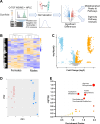
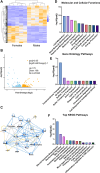
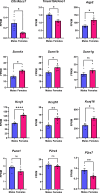

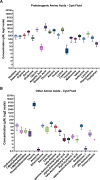
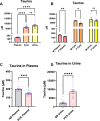
Similar articles
-
Metabolomic profiling of renal cyst fluid in advanced ADPKD: insights from dialysis and transplantation cohorts.Metabolomics. 2025 Jun 26;21(4):90. doi: 10.1007/s11306-025-02291-7. Metabolomics. 2025. PMID: 40569531 Free PMC article.
-
Raising serum uric acid with a uricase inhibitor worsens PKD in rat and mouse models.Am J Physiol Renal Physiol. 2024 Jun 1;326(6):F1004-F1015. doi: 10.1152/ajprenal.00372.2023. Epub 2024 Apr 18. Am J Physiol Renal Physiol. 2024. PMID: 38634129 Free PMC article.
-
Description of metabolic differences between castrated males and intact gilts obtained from high-throughput metabolomics of porcine plasma.J Anim Sci. 2025 Jan 4;103:skaf178. doi: 10.1093/jas/skaf178. J Anim Sci. 2025. PMID: 40407809 Free PMC article.
-
Interventions for preventing the progression of autosomal dominant polycystic kidney disease.Cochrane Database Syst Rev. 2024 Oct 2;10(10):CD010294. doi: 10.1002/14651858.CD010294.pub3. Cochrane Database Syst Rev. 2024. PMID: 39356039
-
Perioperative administration of buffered versus non-buffered crystalloid intravenous fluid to improve outcomes following adult surgical procedures.Cochrane Database Syst Rev. 2017 Sep 21;9(9):CD004089. doi: 10.1002/14651858.CD004089.pub3. Cochrane Database Syst Rev. 2017. PMID: 28933805 Free PMC article.
Cited by
-
Wheat-Based Protein Slows Disease Progression in Pkd1 Knockout Mice.Function (Oxf). 2025 Aug 1;6(4):zqaf026. doi: 10.1093/function/zqaf026. Function (Oxf). 2025. PMID: 40493450 Free PMC article.
-
Mechanistic Insights into the Pathogenesis of Polycystic Kidney Disease.Cells. 2025 Aug 5;14(15):1203. doi: 10.3390/cells14151203. Cells. 2025. PMID: 40801635 Free PMC article. Review.
-
Metabolic Reprogramming in Autosomal Dominant Polycystic Kidney Disease: Role in Cystogenesis and Novel Therapeutic Approaches.Biomedicines. 2025 Jun 30;13(7):1596. doi: 10.3390/biomedicines13071596. Biomedicines. 2025. PMID: 40722668 Free PMC article. Review.
References
-
- Dicks, E. et al. Incident renal events and risk factors in autosomal dominant polycystic kidney disease: a population and family-based cohort followed for 22 years. Clin. J. Am. Soc. Nephrol.1, 710–717 (2006). - PubMed
-
- Gabow, P. A. et al. Factors affecting the progression of renal disease in autosomal-dominant polycystic kidney disease. Kidney Int.41, 1311–1319 (1992). - PubMed
-
- Fick-Brosnahan, G. M., Belz, M. M., McFann, K. K., Johnson, A. M. & Schrier, R. W. Relationship between renal volume growth and renal function in autosomal dominant polycystic kidney disease: a longitudinal study. Am. J. Kidney Dis.39, 1127–1134 (2002). - PubMed
-
- Orskov, B., Christensen, K. B., Feldt-Rasmussen, B. & Strandgaard, S. Low birth weight is associated with earlier onset of end-stage renal disease in Danish patients with autosomal dominant polycystic kidney disease. Kidney Int.81, 919–924 (2012). - PubMed
MeSH terms
Substances
Grants and funding
LinkOut - more resources
Full Text Sources

